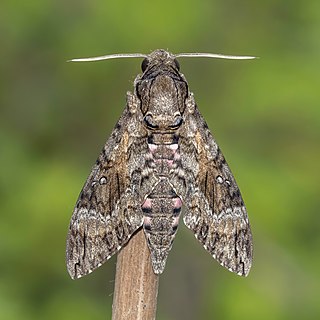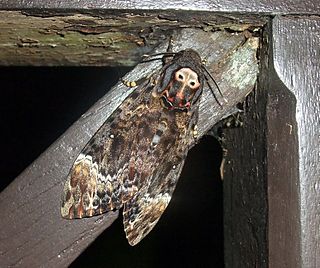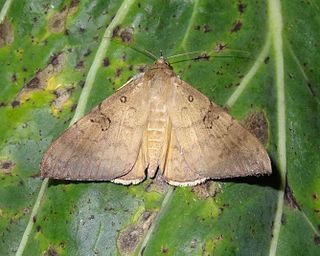
The geometer moths are moths belonging to the family Geometridae of the insect order Lepidoptera, the moths and butterflies. Their scientific name derives from the Ancient Greek geo γεω, and metron μέτρον "measure" in reference to the way their larvae, or inchworms, appear to measure the earth as they move along in a looping fashion. A very large family, it has around 23,000 species of moths described, and over 1400 species from six subfamilies indigenous to North America alone. A well-known member is the peppered moth, Biston betularia, which has been subject of numerous studies in population genetics. Several other geometer moths are notorious pests.

The blotched emerald is a moth of the family Geometridae. The species was first described by Michael Denis and Ignaz Schiffermüller in 1775. It is found throughout Europe and the Near East. It has a scattered distribution in England and Wales, but is absent from Scotland and Ireland.

Ceratomia amyntor, the elm sphinx or four-horned sphinx, is a North American moth in the family Sphingidae. The species was first described by Carl Geyer in 1835. It has a wingspan of 3+1⁄4-4+1⁄2 inches. As the name suggests, the larvae (caterpillars) feed on elm trees (Ulmus), but they can also be found feeding on birch (Betula), basswood (Tilia), and cherry (Prunus). When the caterpillars are ready, they crawl to the bottom of the host tree, where they crawl underneath the soil and pupate and may overwinter underground if late enough into the year. Vegetable growers should be aware of this larvae due to its insatiable appetite. One of these larvae are capable in devouring huge amounts of plant's foliage and even succulent stems.

Agrius cingulata, the pink-spotted hawkmoth or sweetpotato hornworm, is a moth in the family Sphingidae. The species was first described by Johan Christian Fabricius in 1775.

Citheronia regalis, the regal moth or royal walnut moth, is a North American moth in the family Saturniidae. The caterpillars are called hickory horned devils. The adult (imago) has a wingspan of 3.75–6.1 in (9.5–15.5 cm). The species was first described by Johan Christian Fabricius in 1793.

Daphnis nerii, the oleander hawk-moth or army green moth, is a moth of the family Sphingidae. It was described by Carl Linnaeus in his 1758 10th edition of Systema Naturae.

Polygonia interrogationis, commonly called the question mark butterfly, is a North American nymphalid butterfly. It lives in wooded areas, city parks, generally in areas with a combination of trees and open space. The color and textured appearance of the underside of its wings combine to provide camouflage that resembles a dead leaf. The adult butterfly has a wingspan of 4.5–7.6 cm (1.8–3.0 in). Its flight period is from May to September. "The silver mark on the underside of the hindwing is broken into two parts, a curved line and a dot, creating a ?-shaped mark that gives the species its common name."

Orgyia leucostigma, the white-marked tussock moth, is a moth in the family Erebidae. The species was first described by James Edward Smith in 1797. The caterpillar is very common especially in late summer in eastern North America, extending as far west as Texas, California, and Alberta.

The giant swallowtail is the largest butterfly in North America. It is abundant through many parts of eastern North America; populations from western North America and down into Panama are now considered to belong to a different species, Papilio rumiko. Though it is often valued in gardens for its striking appearance, its larval stage can be a serious pest to citrus farms, which has earned its caterpillars the names orange dog or orange puppy. The giant swallowtail caterpillars possess remarkable camouflage from predators by closely resembling bird droppings. They use this, along with their osmeteria, to defend against predators such as wasps, flies, and vertebrates.

Hyles gallii, the bedstraw hawk-moth or galium sphinx, is a moth of the family Sphingidae. The species was first described by S. A. von Rottemburg in 1775.

Hyles lineata, also known as the white-lined sphinx, is a moth of the family Sphingidae. They are sometimes known as the hummingbird moth because of their bird-like size and flight patterns.

Acherontia lachesis, the greater death's head hawkmoth or bee robber, is a large sphingid moth found in India, Sri Lanka and much of the Oriental region. It is one of the three species of death's-head hawkmoth genus, Acherontia. The species was first described by Johan Christian Fabricius in 1798. It is nocturnal and very fond of honey; they can mimic the scent of honey bees so that they can enter a hive unharmed to get honey. Their tongue, which is stout and very strong, enables them to pierce the wax cells and suck the honey out. This species occurs throughout almost the entire Oriental region, from India, Pakistan and Nepal to the Philippines, and from southern Japan and the southern Russian Far East to Indonesia, where it attacks colonies of several different honey bee species. It has recently become established on the Hawaiian Islands.

Mocis frugalis, the sugarcane looper, is a moth of the family Erebidae. The species was first described by Johan Christian Fabricius in 1775. It is found in several parts of the world, including India, Sri Lanka, West African countries and other Oriental regions. The adult is a fruit piercer and a major pest of crops.

Thalera fimbrialis, the Sussex emerald, is a species of moth of the family Geometridae, found in Europe and across the Palearctic to the area surrounding the Amur River in China. It was described by the Italian physician and naturalist Giovanni Antonio Scopoli in 1763.

Haematopis is a monotypic moth genus in the family Geometridae erected by Jacob Hübner in 1823. Its only species, Haematopis grataria, the chickweed geometer, was first described by Johan Christian Fabricius in 1823. It is found throughout the United States. In Canada it is found from Quebec to Alberta, north to the Northwest Territories.

Synchlora is a genus of moths in the family Geometridae erected by Achille Guenée in 1857. Adult Synchlora members often have leaf green wings, while larvae occasionally have the property of adorning themselves with pieces of plants in the pursuit of camouflage. The name of the genus comes from Greek, with "syn-" meaning "with", and "chlor" meaning "green".

Oxyodes scrobiculata, the longan semi-looper or longan leaf-eating looper, is a moth of the family Erebidae. The common name "looper" is used despite looper moths generally being in the family Geometridae. The species was first described by Johan Christian Fabricius in 1775. It is found in the Indo-Australian tropics of India, Sri Lanka, Myanmar, China, east to Guam, Queensland, New Caledonia, Fiji, Samoa and Tonga.

Oraesia emarginata is a species of moth of the family Erebidae first described by Johan Christian Fabricius in 1794. It is found in Australia, New Caledonia, Indonesia, New Guinea, Pakistan, the Philippines, India, Sri Lanka, Sulawesi, Taiwan, China, Japan, Korea and Nepal as well as Eritrea, Ethiopia, Kenya, Namibia, Nigeria, South Africa, Tanzania, the Gambia, Uganda, Oman and Yemen.

Chesias rufata, the broom-tip, is a moth of the family Geometridae. It was described by Johan Christian Fabricius in 1775. It has a wide range in central and western Europe, including Great Britain and Ireland. It is also found from Morocco to Asia Minor.The species prefers heaths, bushy slopes and rocky valleys which favour its foodplants. It is found up to 1,500m in the Alps.

Cleora scriptaria, the kawakawa looper moth, is a moth in the family Geometridae endemic to New Zealand.
























